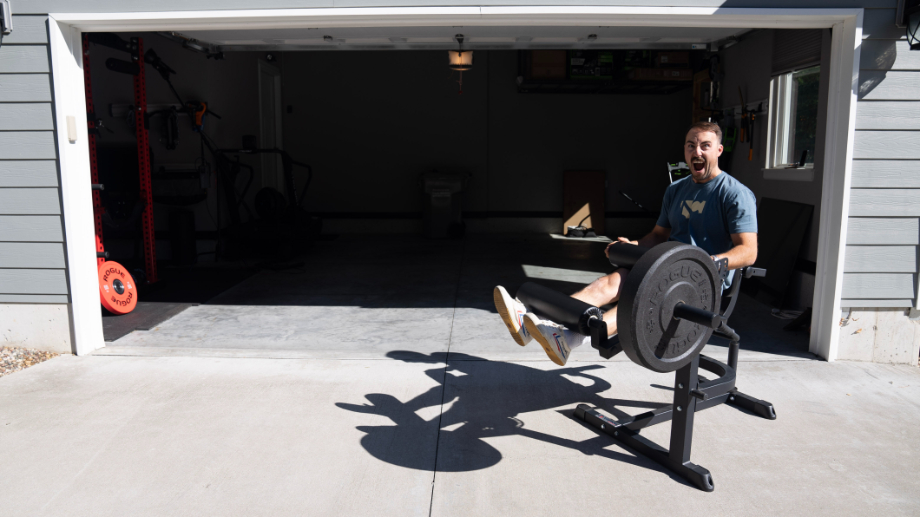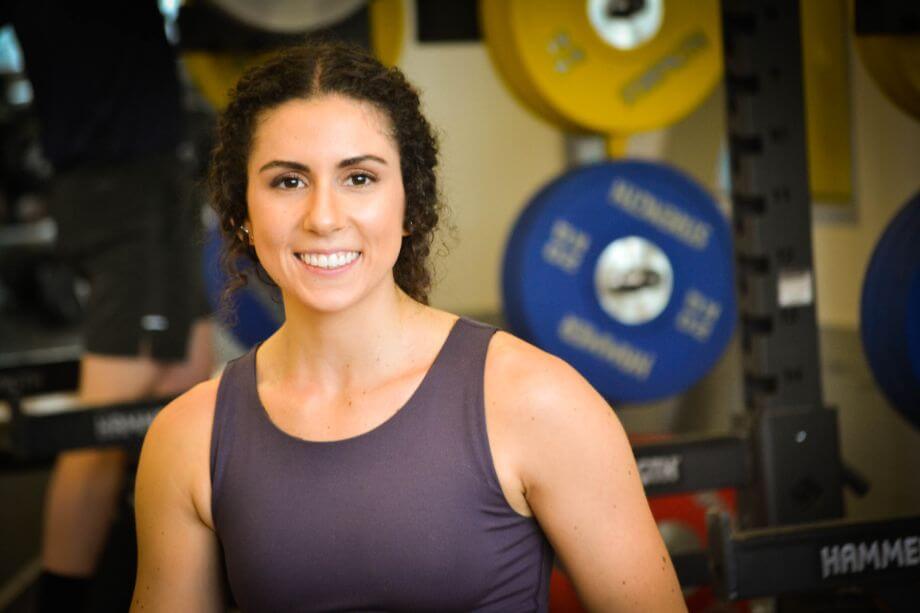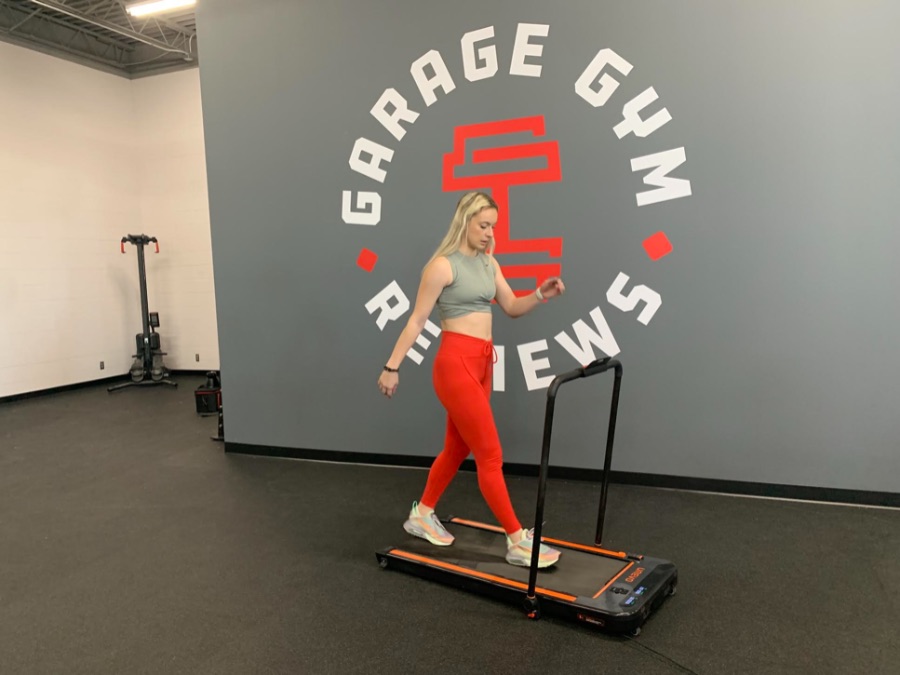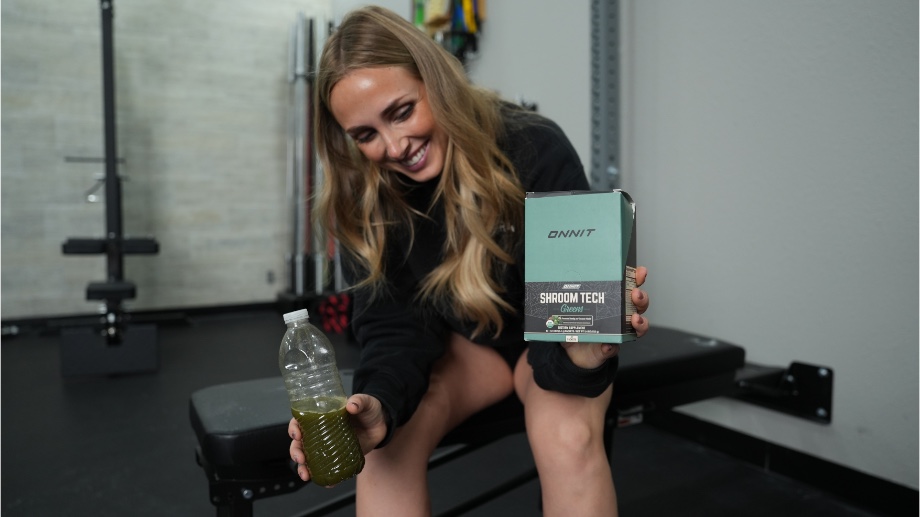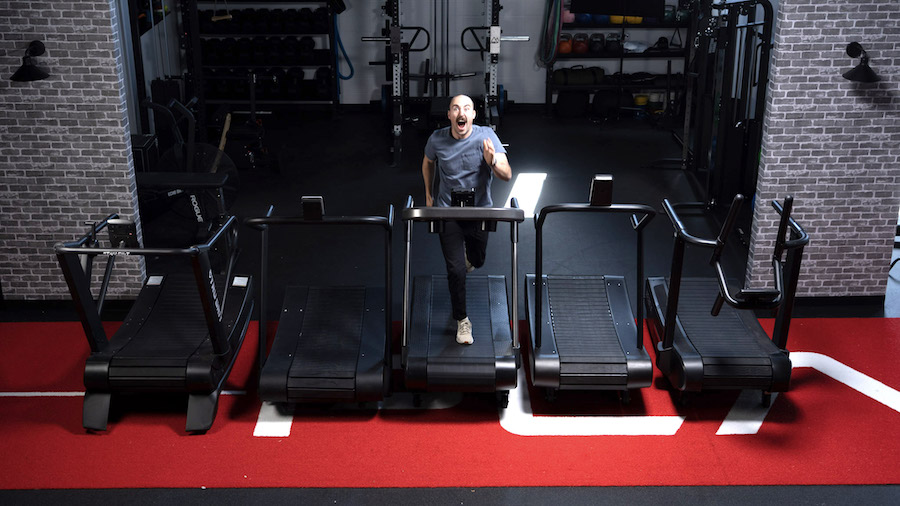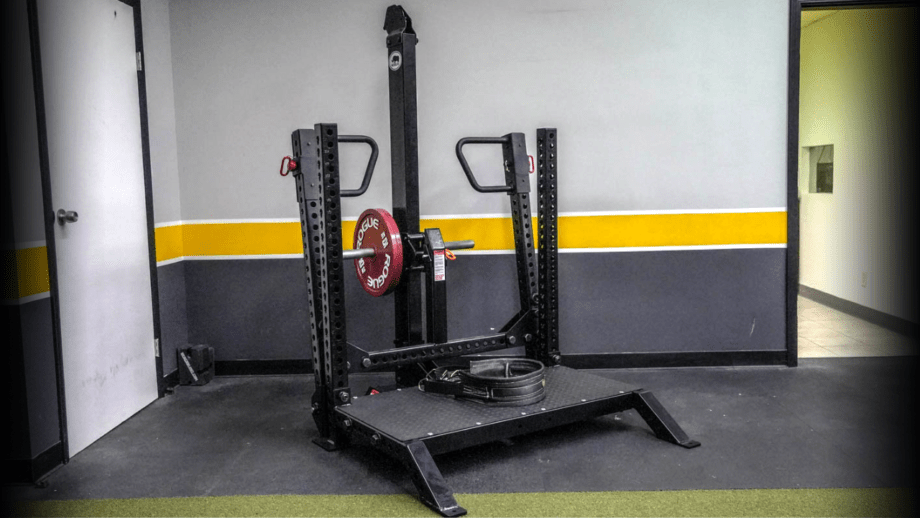Compound exercises get all the praise, but isolation exercises have a place in a well-rounded fitness routine.
Most fitness professionals harp on the importance of multi-joint exercises like squats and presses—guilty! But as a certified personal trainer, I can’t argue that single-joint exercises don’t have a place in any fitness routine. They come with their own unique suite of benefits and drawbacks, and as always, it’s all about finding out what works for you.
Whether you’re a beginner, a bodybuilder, a senior, or you have suffered an injury, you stand to benefit from performing isolation exercises. Ahead, is a complete guide to what you should know about these movements.
What Are Isolation Exercises?
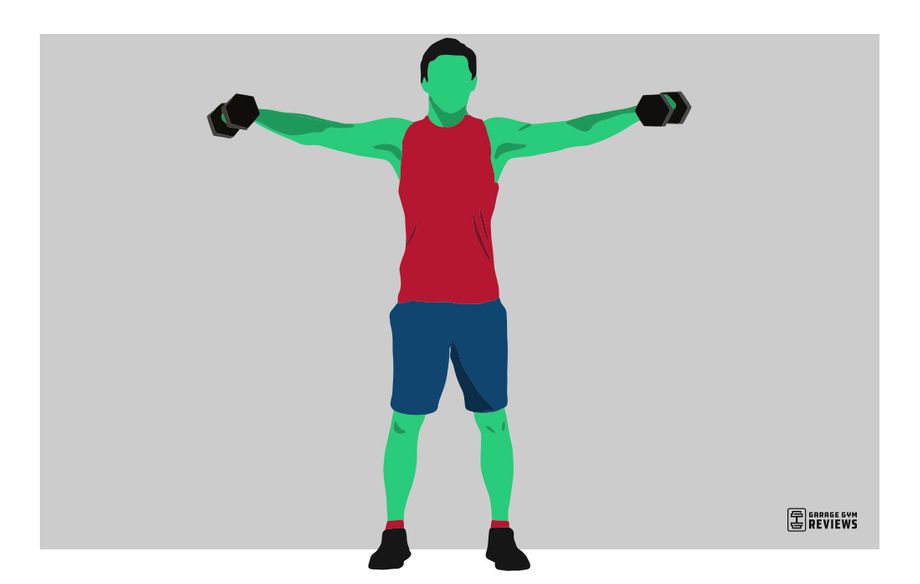
Isolation exercises include all exercises that—wait for it—isolate a joint movement and target one specific muscle or muscle group.
Let’s visualize, using the knee joint and quadriceps muscles as an example:
- Your knee flexes (bends) and extends (straightens).
- When you flex (bend) the knee, your hamstrings contract and your quads stretch.
- When you extend (straighten) the knee, your quads contract and your hamstrings stretch.
- To isolate your quadriceps from all other muscles, you need to perform extension of the knee (straightening the leg) in isolation.
- So, you’d do leg extensions, usually on a machine or with dumbbells (we’ll go over exercise options later) to isolate your quads.
You may be wondering: What’s the point of isolation exercises?
Well, there are several benefits to them, which we explain later in this guide, but the gist is this: Isolation exercises work a singular joint movement pattern and the muscles that move the joint in that way, the purpose being targeted muscle growth or rehabilitation.
Isolation Exercises vs Compound Exercises
You now know what isolation movements are. Another term you may have heard is “compound exercises.”
Compound exercises include any movement that engages more than one joint, and thus do not isolate a specific muscle group. These are often referred to as “functional movements” and include all of the big barbell lifts—squats, deadlifts, bench press, overhead press, and all of their variations—as well as lunges, rows, and much more.
Because compound movements don’t isolate a muscle group, we don’t cover them in this guide. (But we have guides to the best barbell exercises and best dumbbell exercises that include dozens of compound strength training exercises.)
RELATED: Dumbbell Leg Workout
Best Isolation Exercises for Every Muscle Group
Here, we give you more than 30 of the best isolation moves to add to your workout routine. For each move, we provide the stimulus, equipment needed, and a step-by-step guide on how to perform it.
Best Isolation Exercises for Lower Body
Your lower body consists of more than 100 muscles—more than 50 in each lower extremity. For the sake of simplicity we’ll focus on the major muscles in the lower body in groups: quadriceps, hamstrings, calves, and glutes.
Quads
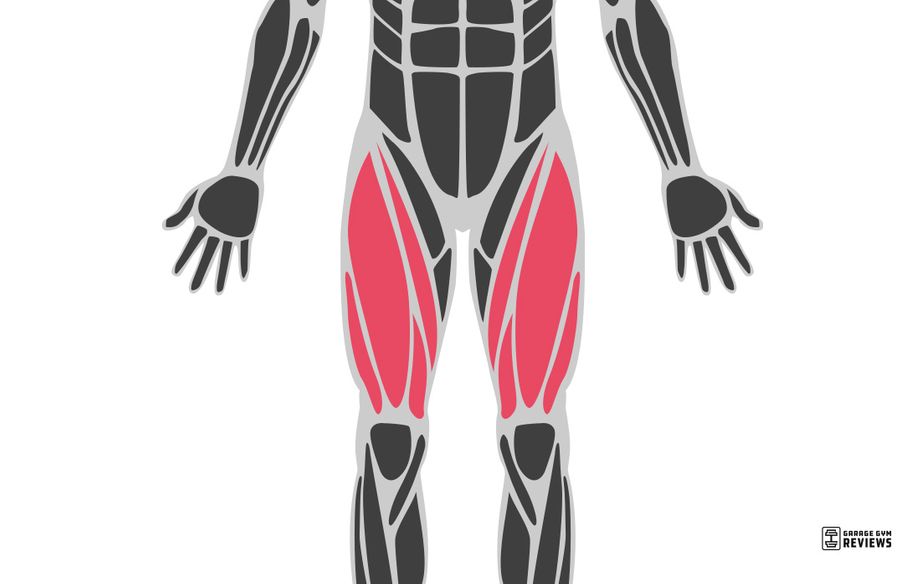
Your quads include all of the muscles that extend (straighten) the knee. It’s a tough group to isolate, given that there’s only one way to do so—straighten the leg. Here are our favorite quad isolation exercises.
Machine Leg Extension

Why it’s great: If you can access a leg extension machine, this exercise provides the most controlled quad isolation experience and the most opportunity for progression.
Equipment needed: Leg extension machine
How to do it:
- Sit in the leg extension machine and adjust the seat and lever to your height according to the instructions on the machine.
- Set the weight using the pin in the weight stack.
- With your arms resting in your lap or on the arm rests, contract your quadriceps to fully straighten your leg.
- Pause for a second at the top of the movement, and then lower the weight with control.
Dumbbell Leg Extension

Why it’s great: This is a phenomenal alternative to the machine version of this leg exercise, and although it’s unlikely you can move as much weight this way, it can be done with minimal equipment and in small spaces.
Equipment needed: Weight bench or plyo box and dumbbells
How to do it:
- Sit on a box or weight bench to where the backs of your knees slightly graze the edge. Sit up straight and keep your spine in a neutral position. Rest your hands on the box or bench.
- Grab the handle of a dumbbell with your feet, squeezing the handle between your arches and allowing the head of the dumbbell to rest on the top of your feet. IContract your quadriceps to fully straighten your leg.
- Pause for a second at the top of the movement, and then lower the weight with control.
Hamstrings
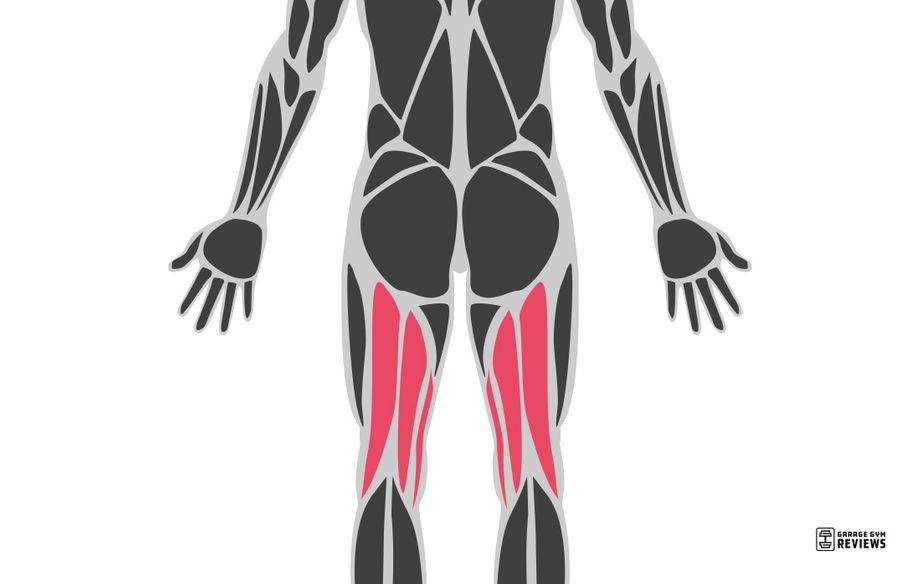
The hamstrings have the opposite function of the quads: They flex (bend) the knee rather than extend it. Your hammies are important for everything from walking to squatting to bending over.
Machine Hamstring Curl

Why it’s great: The machine provides a controlled experience to allow for thorough targeting and has opportunities for progression.
Equipment needed: Leg curl machine
How to do it:
- Lie belly-down on the leg curl machine and place your feet in the proper position according to the instructions on the machine.
- Adjust the weight by setting the weight pin in the stack where you want it.
- Grip the handles firmly.
- Contract your hamstrings to bend your knee to your full range of motion.
- Lower the weight down with control.
Dumbbell Hamstring Curl

Why it’s great: This machine alternative requires minimal equipment and still effectively targets the hamstrings.
Equipment needed: Weight bench (preferably a decline one) and dumbbells
How to do it:
- Set up a dumbbell (with or without an accessory like Monkey Feet) behind a weight bench. Lie belly-down on the bench with your toes grazing the ground.
- Squeeze the handle of the dumbbell in between the arches of your feet and allow the head of the bell to rest on the soles of your shoes.
- Contract your hamstrings to bend your knee to your full range of motion.
- Lower the weight down with control.
Standing Hamstring Curl

Why it’s great: With multiple equipment options, the standing leg curl challenges your hamstring muscles in a different way than its lying-down counterparts.
Equipment needed: Standing leg curl machine; cable machine with ankle attachment; or ankle weights
How to do it (with cable machine):
- Lower the cable pulley to the bottom position and attach the ankle strap accessory.
- Adjust the weight with the weight pin.
- Secure the ankle strap around your ankle. Plant the other leg firmly with pressure throughout the entire foot, keeping a slight bend in your knee.
- Contract your hamstrings to bend your knee to your full range of motion.
- Lower the weight down with control.
Glutes
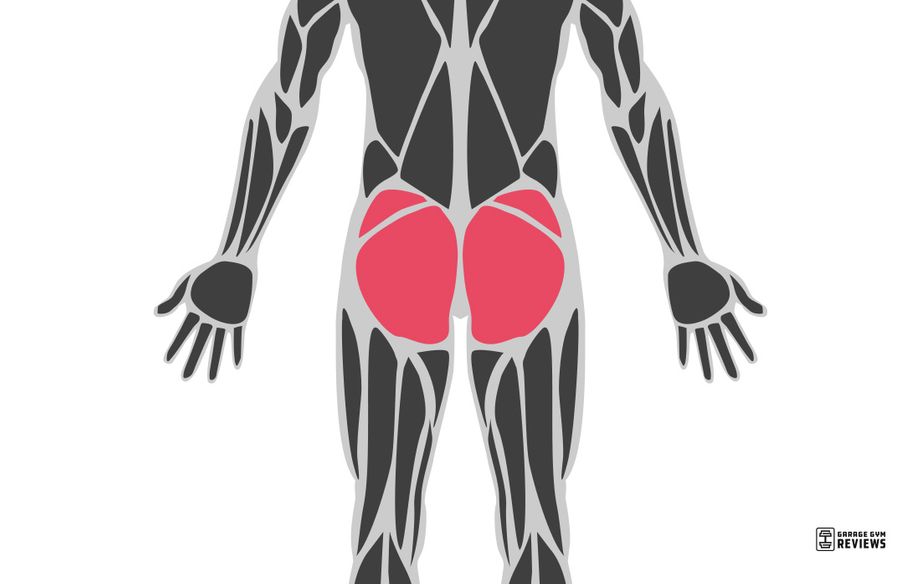
Ah, the mighty glutes. Actually consisting of three muscles on each limb—the gluteus maximus, medius, and minimus—these large muscles play a major role in almost every movement pattern (and in physique-building).
Resistance Band Hip Abductions

Why it’s great: Hip abductions target the muscles that move your legs outward from your body. Strengthening these improves your walking and running gait; your squat performance; and overall stabilization and health of the hip joints.
Equipment needed: Mini resistance band
How to do it:
- Place a mini resistance band around your legs, just above the knees.
- Hold onto a post or press your hands against a wall for stability.
- With a slight bend in your hips and no movement from your knees, squeeze your glutes and move your leg directly away from the center of your body in a lateral motion.
- With control, return your leg back to your starting position.
Glute Kickbacks

Why it’s great: Kickbacks primarily recruit the gluteus maximus, the largest muscle in your body. These are great for physique-focused individuals as well as anyone who’s concerned with the stability of their hip joints.
Equipment needed: Cable machine with ankle attachment or hip circles (mini resistance bands)
How to do it (with a resistance band):
- Place a mini resistance band around your legs, just above the knees.
- Hold onto a post or press your hands against a wall for stability.
- With a slight bend in your hips and no movement from your knees, squeeze your glutes and kick your leg backwards.
- Squeeze at your end range of motion before returning to your starting position.
Sumo Good Mornings

Why it’s great: Good mornings could be considered a compound exercise, but the emphasis that the sumo version places on the gluteus medius compelled me to include them in this guide.
Equipment needed: Resistance bands or barbell and weight plates
How to do it (with a resistance band):
- Stand on a long looped resistance band with your feet wider than hip-width apart.
- Loop the resistance band around your shoulders while maintaining your footing on the band, so that it creates resistance.
- Hinge at your hips, sending your glutes backwards. Keep a slight bend in your knee.
- Squeeze your glutes to push your hips forward, back to the starting position. Pause at full hip extension for extra stimulation to the glutes.
Calves
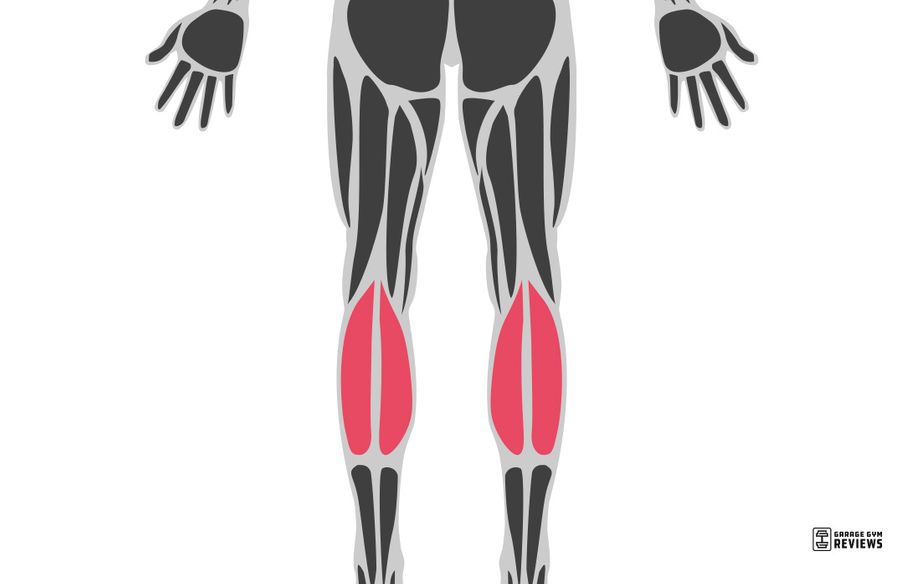
Your calves consist of two main muscles: the gastrocnemius and soleus. There’s also the anterior tibialis, which is the muscle that runs along the front of your lower leg and attaches to your shinbone. These two calf exercises target the former.
Weighted Calf Raise

Why it’s great: Functional in nature, this exercise effectively strengthens the two major muscles that make up your calf.
Equipment needed: Two dumbbells or two kettlebells; or barbell and weight plates
How to do it (with dumbbells or kettlebells):
- Hold a weight in each hand with your arms down by your sides. Engage your back muscles to keep from hunching over.
- Lift up onto your toes.
- Pause for a second or two, and then slowly lower your heels back down to the ground.
Weighted Tip-Toe Walk

Why it’s great: Walking on your tip-toes with weight will provide a unique stimulus to your lower legs and enhance muscle growth and strength.
Equipment needed: Two dumbbells or two kettlebells
How to do it:
- Hold a weight in each hand with your arms down by your sides. Engage your back muscles to keep from hunching over.
- Lift up onto your toes.
- Carefully and slowly walk forward on your tip-toes for 10 to 50 feet.
Best Isolation Exercises for Upper Body
Whether you’re trying to get jacked, maintain strength, balance out your physique, or rehabilitate an injury, these upper body isolation exercises are good additions to your workout program.
Biceps
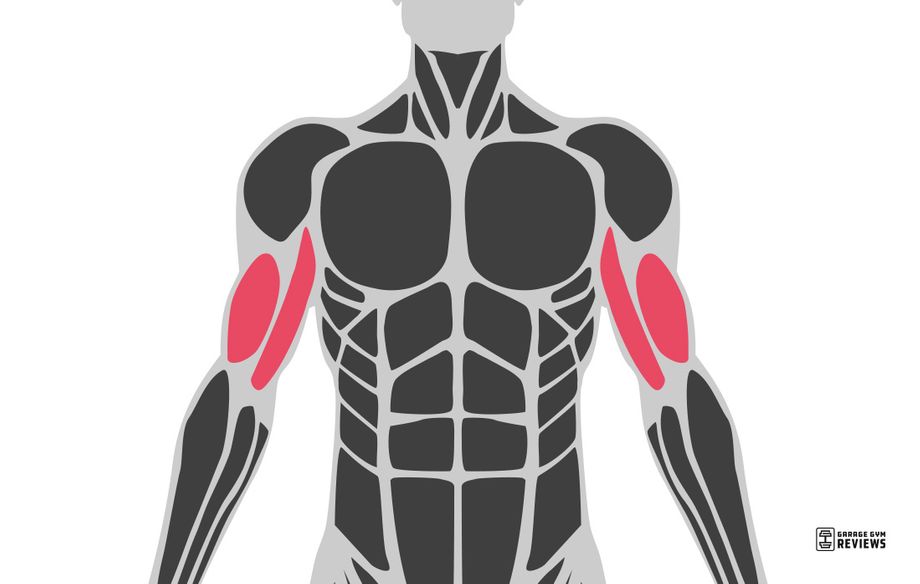
Upper-body day wouldn’t be complete without some biceps curls. Here are some variations to try on your next arm day.
Neutral-Grip Biceps Curl

Why it’s great: A classic, the biceps curl can be done with a variety of equipment and is a highly effective isolation movement.
Equipment needed: Dumbbells or barbell and plates
How to do it (with dumbbells):
- Hold a dumbbell in each hand with your palms facing away from your body.
- Bend your elbow and bring the weights toward your chest.
- Squeeze your biceps at the top and then slowly extend your elbows back to the starting position.
Incline Biceps Curl

Why it’s great: Positioning your body at an incline adds an additional challenge to the classic neutral-grip biceps curl.
Equipment needed: Incline weight bench and dumbbells
How to do it:
- Sit on an incline bench and hold a dumbbell in each hand with your arms extended by your sides.
- Bend your elbow and bring the weights toward your chest.
- Squeeze your biceps at the top and then slowly extend your elbows back to the starting position.
Wide Grip Barbell Curl

Why it’s great: Importantly, using a wide grip for curls increases muscle recruitment from the short head of the biceps muscle, which aids in building all-around arm mass and strength.
Equipment needed: Barbell and plates
How to do it:
- Load a barbell with adequate weight to challenge yourself, but not so heavy that you’ll compromise your technique.
- Stand with your feet about shoulder-width apart.
- Grip the barbell with a wide grip—if there are knurl markings, grip outside of the two neutral-grip indicators on the barbell.
- Hold the barbell with your arms extended.
- Bend your elbow and bring the weights toward your chest.
- Squeeze your biceps at the top and then slowly extend your elbows back to the starting position.
Triceps
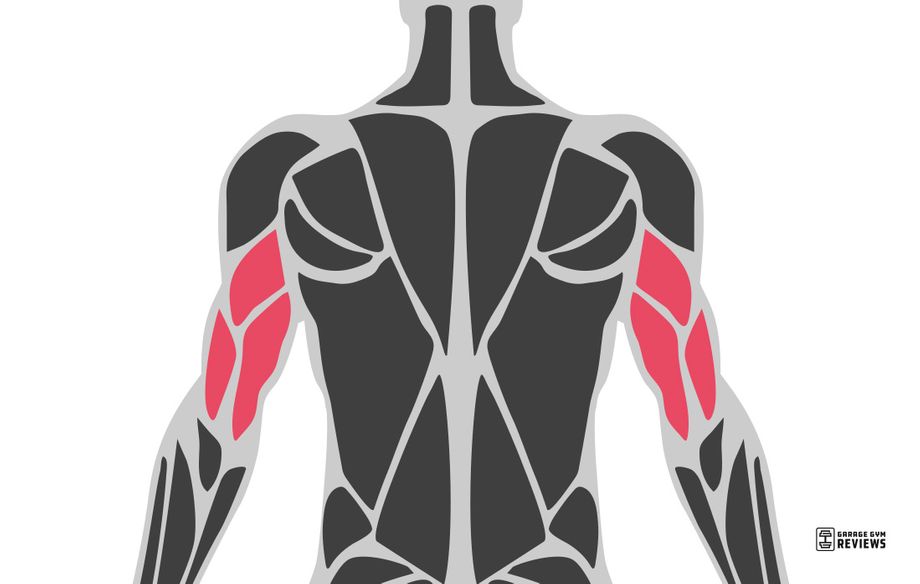
Your triceps are important for any and every movement that involves pushing with your arms. Should you ever find yourself hoisting a heavy box up onto a shelf, you’ll be glad you incorporate these tricep exercises into your program.
Overhead Triceps Extension

Why it’s great: These isolate your elbow flexor muscles with minimal equipment.
Equipment needed: Dumbbell
How to do it:
- Stand up tall with your feet about shoulder-width apart.
- Hold a dumbbell with both hands above your head.
- Bend your elbows so that the dumbbell lowers behind your head, keeping your elbows tucked close to your body
- Squeeze your triceps to push the dumbbell back to the starting position.
- Take care not to hyperextend your back or use momentum from your lower body to move the dumbbell.
Skullcrushers

Why it’s great: By positioning yourself in a lying position, you’ll alter the stimulus from standing triceps extensions and provide a new challenge to your muscles.
Equipment needed: Weight bench, dumbbell
How to do it:
- Lie face-up on a flat bench.
- Hold a dumbbell with both hands. Extend your arms above your chest.
- Bend your elbows so that the dumbbell lowers behind your head, keeping your elbows tucked in close to your body.
- Squeeze your triceps to push the dumbbell back to the starting position.
- Take care not to hyperextend your back; keep your lower back pressed into the bench.
Triceps Push-Down

Why it’s great: With a cable machine, you have a ton of room for progression in the elbow extension movement pattern. You can also mimic this movement pattern with resistance bands, although there’s less room for progression.
Equipment needed: Cable machine or resistance band and pull-up bar
How to do it (with a resistance band):
- Loop a resistance band around a sturdy pull-up bar or squat rack with a top bar.
- Grab the band with both hands, palms facing down.
- Use your triceps to press the band down, keeping your elbows close to your body.
- Slowly return to the starting position.
Forearms
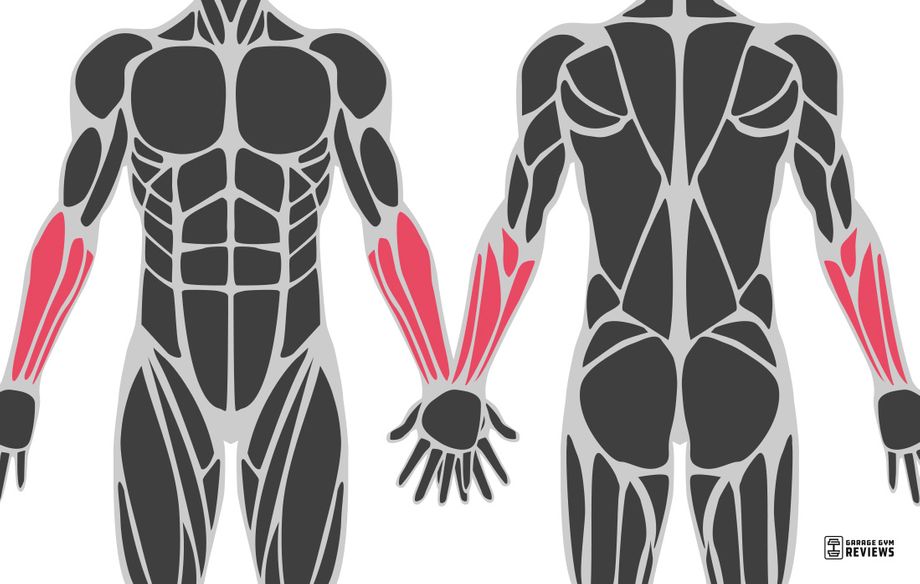
What are good biceps and triceps worth if you don’t have the forearms to match? In all seriousness, the forearms are an oft-forgotten muscle group and these exercises can beef up the muscles from your wrist to your elbow.
Wrist Curls

Why it’s great: This exercise targets the inner portion of your forearm with minimal equipment.
Equipment needed: Weight bench or box, dumbbells
How to do it:
- Kneel next to a weight bench or box and rest your forearm on it with your palm facing up. Hold a dumbbell in this hand.
- Contract your forearm muscles to lift the dumbbell as high as you can. The range of motion on this exercise is very small.
- Lower the dumbbell back to the starting position.
Reverse Wrist Curls

Why it’s great: A reverse wrist curl isolates the smaller muscles on the top/outer portion of your forearm for well-rounded wrist and forearm strength.
Equipment needed: Weight bench or box, dumbbells
How to do it:
- Kneel next to a weight bench or box and rest your forearm on it with your palm facing down. Hold a dumbbell in this hand.
- Contract your forearm muscles to lift the dumbbell as high as you can. The range of motion on this exercise is very small.
- Lower the dumbbell back to the starting position.
Standing Suitcase Hold

Why it’s great: This exercise technically works more than one muscle group (any static hold does), but it will tax your grip. So, it’s functional and has isolated muscle-building potential.
Equipment needed: Two dumbbells or kettlebells
How to do it:
- Stand tall with your feet shoulder-width apart.
- Hold a heavy weight in each hand with your arms extended by your sides.
- Squeeze your shoulder blades together and tighten your core to prevent slumping or arching your back.
- Hold this position for 30 to 60 seconds, focusing on your grip.
Chest
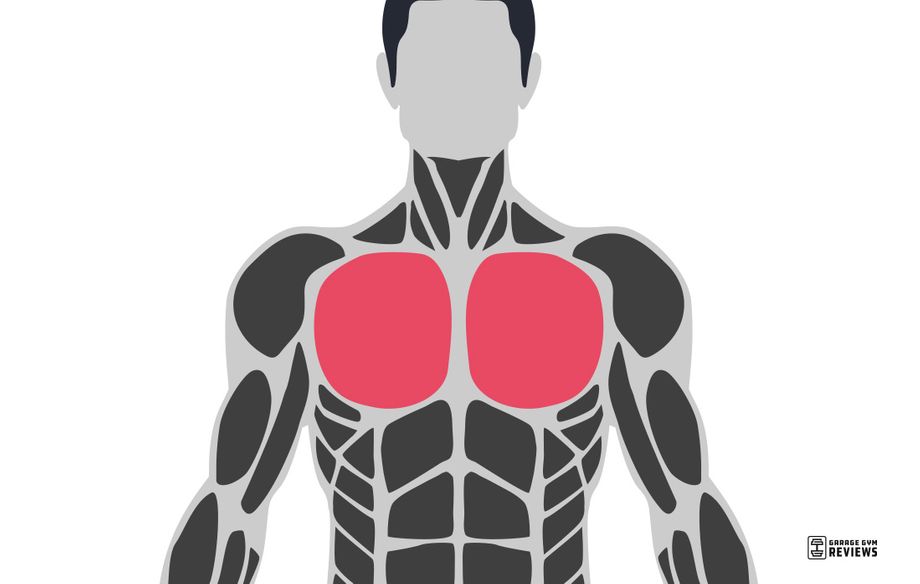
The chest muscles are some of the easiest to isolate. That’s good news for anyone who wants to build a stereotypical bodybuilder’s physique through hypertrophy or who simply needs to increase their pushing strength.
Dumbbell Chest Fly

Why it’s great: The chest fly will build strength and mass in your pecs, as well as your anterior deltoids for a well-rounded upper body.
Equipment needed: Weight bench, dumbbells
How to do it:
- Lie face-up on a flat weight bench, holding a dumbbell in each hand.
- To start, extend your arms above your body so that the dumbbells hover above your chest.
- With a slight bend in your elbows, lower your arms out to the sides. Stop when your arms are about parallel to the bench.
- Contract your pectoral muscles to bring your arms back to center; squeeze your chest before starting another rep.
Upward Fly

Why it’s great: This chest exercise uniquely isolates the lower pectorals, which contributes to overall pushing strength and physique.
Equipment needed: Dumbbells or cable machine
How to do it (with dumbbells):
- Stand tall with your feet shoulder-width apart and hold a dumbbell in each hand with your palms facing away from you.
- With a slight bend in your elbows, lift the dumbbells upward, focusing on the contraction in your lower pec muscles.
- Bring your arms parallel to the floor and squeeze your pecs.
- Lower the dumbbells back to the starting position.
Crossover

Why it’s great: You’ll feel the burn in your pectoralis majors, and can manipulate the stimulus by changing your pulley position, when you do crossovers.
Equipment needed: Cable machine or resistance bands and two anchoring points
How to do it (with resistance bands):
- Anchor two resistance bands to a sturdy object (like a squat rack or a suspension system) with a few feet of space between them.
- Grab a band with each hand. Your arms should be fully extended, but not pulled backwards.
- Use your chest muscles to push against the resistance band and bring your arms close together.
- Squeeze your chest muscles at the end range of motion and then return to starting with control.
Back
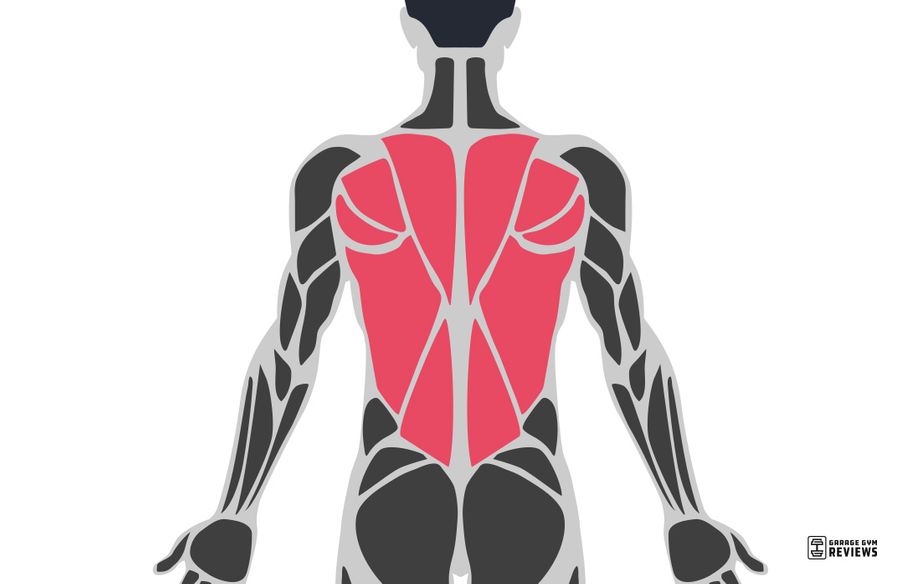
While we’re big fans of pull-ups and bent-over rows, we also love these isolation movements for back muscles.
Face Pull

Why it’s great: The face pull exercise recruits the muscles in your upper back and can be done in multiple ways.
Equipment needed: Cable machine or resistance bands
How to do it (with resistance bands):
- Anchor a resistance band to a squat rack, pull-up bar, or other sturdy spot. It should be high enough that when you hold it, your arms are at about face level (anywhere from the top of your forehead to your neck).
- Grab the resistance band with both hands, leaving 6 to 12 inches of space between them.
- Step back until there is light tension in the band.
- Bend your elbows to pull the band toward your face, sending your elbows out to the side.
- Slowly extend your arms.
Straight-Arm Pull-Down

Why it’s great: An isolated alternative to the pull-up that targets the latissimus dorsi, straight-arm pull-downs can be incorporated to build a stronger and wider back.
Equipment needed: Cable machine or resistance bands
How to do it (with resistance bands):
- Anchor a resistance band to a squat rack, pull-up bar, or other sturdy spot. It should be high enough that when you hold it, your arms are at about face level (anywhere from the top of your forehead to your neck).
- Step back until there is light tension in the band.
- Without bending your elbows, pull the band straight down until your hands graze your thighs.
- Slowly return your arms to the starting position.
Shrugs

Why it’s great: Shrugs can be done with a variety of equipment and effectively isolate the trapezius muscles.
Equipment needed: Barbell and plates, or dumbbells or kettlebells
How to do it (with dumbbells):
- Hold a dumbbell in each hand with your arms down by your sides.
- Keeping your elbows extended, shrug your shoulders and squeeze at the top.
- Lower the dumbbells back down.
Shoulders
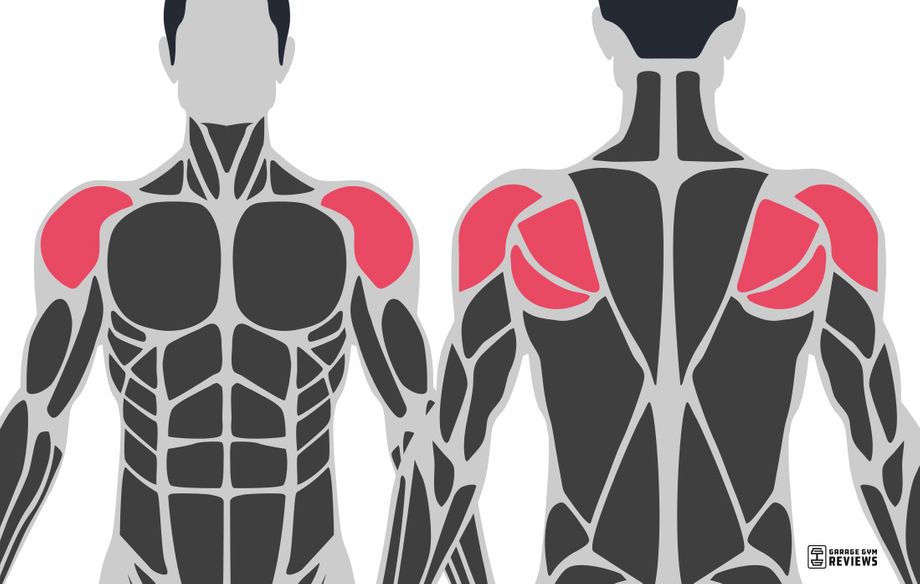
Looking to build boulder shoulders or even out an imbalance in your deltoids? These shoulder isolation exercises will help.
Front Raise

Why it’s great: Your shoulders have three main parts; the anterior, posterior, and lateral sections. Front raises isolate the anterior (front) deltoids.
Equipment needed: Dumbbells
How to do it:
- Stand tall with your feet about shoulder-width apart. Hold a dumbbell in each hand. Let your arms hang in front of your body with palms facing you.
- Keeping your elbows extended, lift the dumbbells straight up until they reach face level.
- Slowly lower your arms back down.
Dumbbell Lateral Raise

Why it’s great: The lateral raise targets the sides of your shoulder muscles and increases lateral stability of the shoulder joint while building that “boulder shoulder” look.
Equipment needed: Dumbbells
How to do it:
- Stand tall with your feet about shoulder-width apart. Hold a dumbbell in each hand. Let your arms hang at your sides with palms facing you.
- Keeping your elbows extended, lift the dumbbells straight up until your arms are parallel to the floor.
- Slowly lower your arms back down.
Reverse Dumbbell Fly

Why it’s great: The dumbbell fly (plural flyes, because one time, someone spelled it like that and it stuck), primarily recruits your rear delts with some help from your traps and rhomboids.
Equipment needed: Dumbbells
How to do it:
- Stand tall with your feet about shoulder-width apart. Hold a dumbbell in each hand. Let your arms hang at your sides with palms facing you.
- Bend your knees slightly and hinge your hips backward until your torso is almost parallel to the floor.
- Let your arms hang down beneath your torso with the dumbbell heads touching.
- Keeping your elbows extended, lift the dumbbells straight up until your arms are parallel to the floor.
- Slowly lower your arms back down.
Best Isolation Exercises for Core
The core is extremely hard to isolate, and depending on who you ask, none of these count as true isolation exercises. Considering your core moves your spine, which consists of 33 bones and multiple joints connecting them all, this is the closest you’ll get.
Obliques
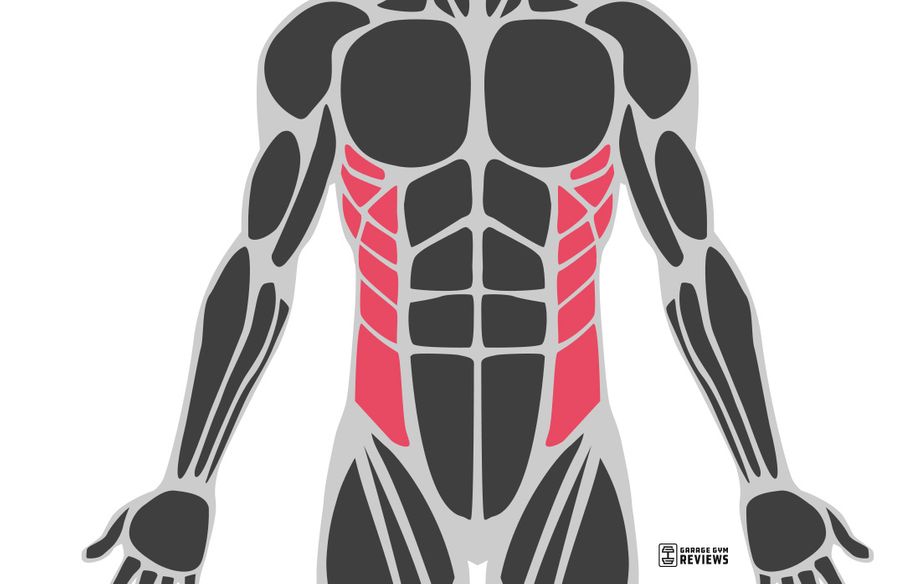
Your obliques are the long muscles that run along your sides, from beneath the pecs to the hips. These muscles are important for bending side-to-side, flexing and extending your spine, and rotating your torso.
Kneeling Woodchop

Why it’s great: Woodchops promote overall core stability and rotational strength thanks to the emphasis on the obliques.
Equipment needed: Dumbbells
How to do it:
- Kneel on the ground with your hips extended.
- Hold a dumbbell with both hands.
- Position your arms in front of your body, hanging down in front of your torso.
- Using your core, lift the dumbbell diagonally to one side, until your arms are extended overhead.
- Slowly return to the starting position.
Kettlebell Oblique Dip

Why it’s great: This simple movement requires minimal equipment but effectively challenges the obliques and mimics many daily movement patterns.
Equipment needed: Dumbbell or kettlebell
How to do it:
- Stand up tall with your feet shoulder-width apart. Hold a weight in one hand.
- Slowly flex your torso to the side on which you’re holding the weight. Allow gravity to pull you, but don’t over-flex. Take care not to bend forward or backwards—just to the side.
- Contract the muscles on the opposite side to bring your torso back to an upright position.
Rectus Abdominis (“6-Pack Muscles”)
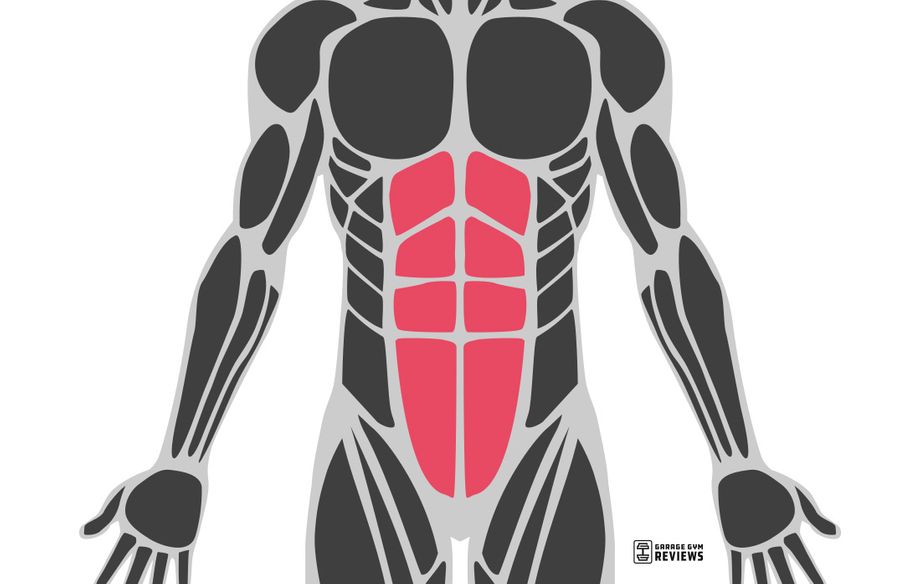
The rectus abdominis is a long, shallow, segmented muscle that makes up what we see as a six-pack in very lean individuals. This muscle is a primary mover for flexion and extension of the spine.
Hollow Body Hold

Why it’s great: With just your body weight, you can subject your core muscles, particularly the rectus abdominis and transverse abdominis, to a serious challenge.
Equipment needed: None
How to do it:
- Lie face-up on the ground. A yoga mat will make this more comfortable.
- Press your lower back into the floor or mat.
- Lift your legs and upper back off of the ground.
- Position your arms above your head.
- Hold this position, continuing to press your lower back into the ground.
Leg Raise

Why it’s great: Like hollow body holds, leg raises work the rectus abdominis muscles with no equipment.
Equipment needed: None
How to do it:
- Lie face-up on the ground. A yoga mat will make this more comfortable.
- Press your lower back into the floor or mat. If you need to, hold onto a post with your hands above your head. Or, keep your arms by your sides.
- Engage your core and lift your legs until they make a 90-degree angle with your torso.
- Slowly lower them back down (don’t plop!).
Who Should Do Isolation Exercises?
You may be wondering if these are worth your time. Our team of certified personal trainers, CrossFit and weightlifting coaches, and other fitness professionals agrees that if you fall into any of the following camps, you definitely stand to benefit from isolation movements.
Bodybuilders and Others Focused on Hypertrophy
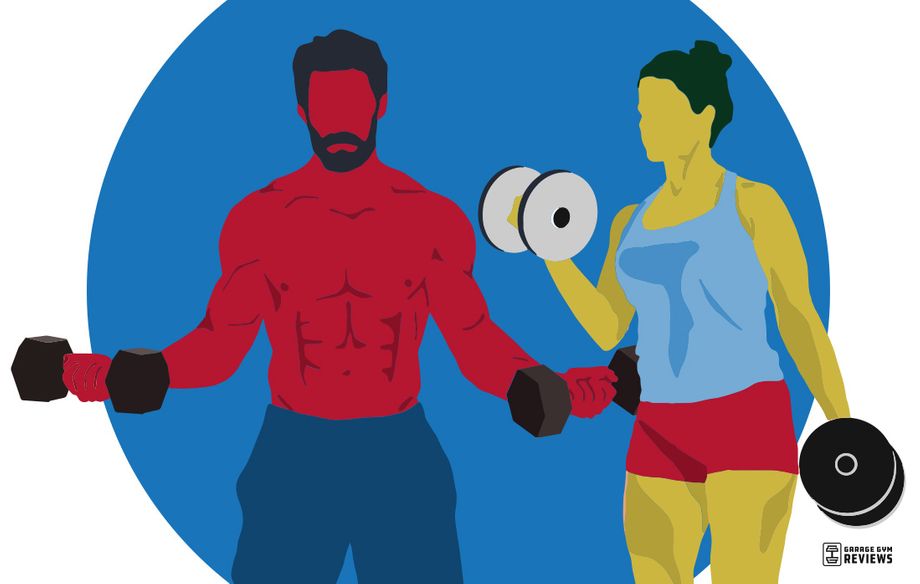
I’d argue that bodybuilders get the most benefit from isolation exercises, since they are so focused on targeted hypertrophy, or muscle growth. However, you don’t have to be a competing athlete to enjoy the results of single-joint strength training. Anyone who wants to beef up a particular muscle group can reap the benefits of isolation exercises.
Older Adults
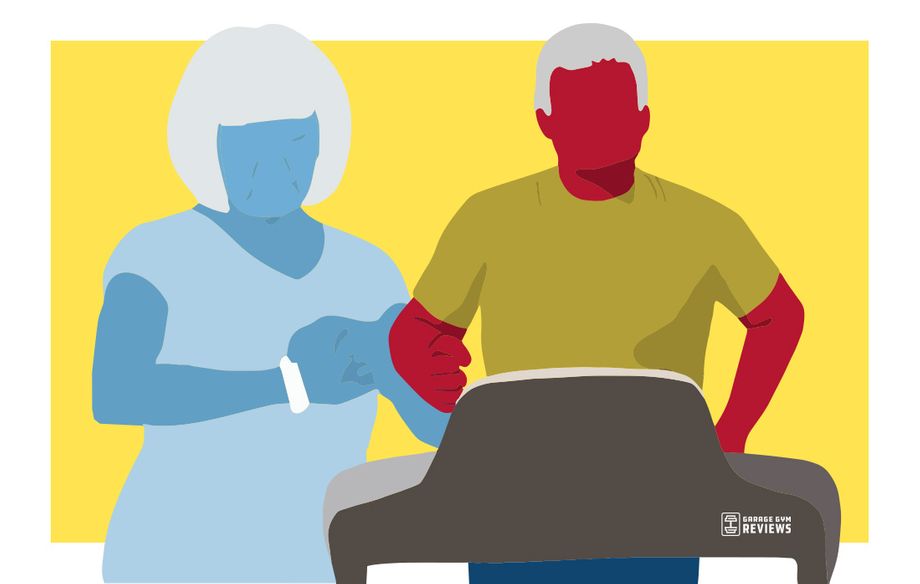
Often, older adults are encouraged to do strength training by their healthcare providers, but may not have the requisite strength or mobility to safely perform compound exercises. While the goal is to be able to perform compound exercises that translate to daily activities, single-joint movements can help seniors build up strength while separately working on mobility, if needed.
“Strength training in general is of the utmost importance for older adults, but isolation exercises can help double-down on any areas that need a lot of improvement,” says Dr. Mike Masi, physical therapist and GGR expert panelist.
“Weight-bearing exercises, which include weighted single-joint exercises, are a top way to reduce one’s risk of osteoporosis and bone fractures,” he says. “Additionally, strengthening the muscles around a joint helps stabilize the joint and this will aid in balance, coordination, and a reduced risk of falling.”
People Who are Rehabbing an Injury
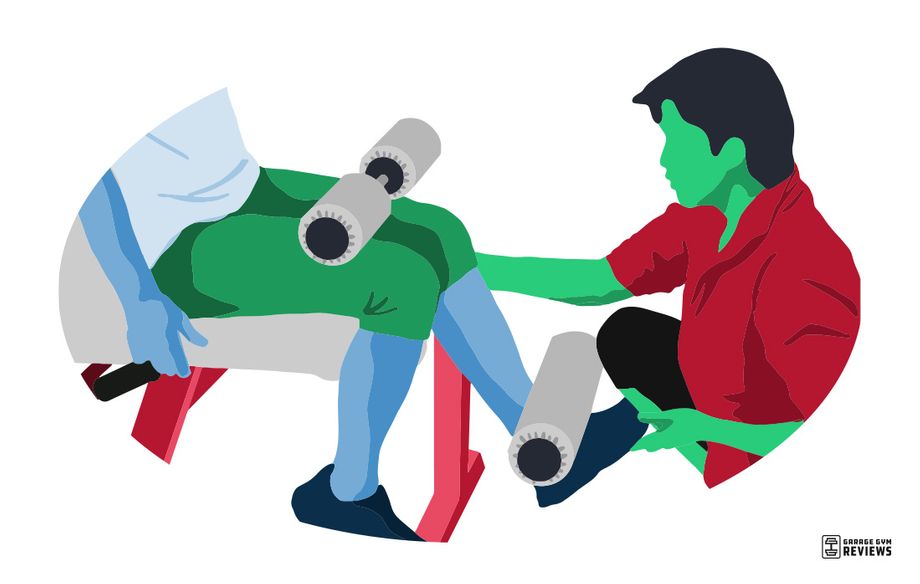
Those who are on the up-and-up from an injury can benefit greatly from isolation exercises. How? Well, for starters, strengthening the muscle around a joint improves the stability and function of that joint. Secondly, isolated strength exercises are a good way to maintain strength in a body region when you have limited range of motion due to an injury.
Physical therapists often prescribe isolation movements for their clients to help them rebuild strength in areas that have atrophied, Dr. Masi says. “Someone with a knee injury, for example, would benefit from quad and hamstring isolation exercises when they are able to safely and adequately flex and extend the knee joint post-injury.”
You should talk to a physical therapist, orthopedist, or other relevant, qualified health professional if you have an injury you think can benefit from isolated strength work.
People Who are Trying to Prevent Injury
You needn’t have a prior or existing injury to benefit from isolation exercises. Quite the contrary: Single-joint movements like pulldowns and pushdowns are great for enhancing the stability of a joint to prevent injury in the first place.
Athletes
For athletes, performance is a priority. And quite often, improving performance as an athlete means honing in on weaknesses. Isolation exercises can help athletes improve essential skills like power and explosiveness to excel in their sport. Isolation moves will also assist athletes in getting rid of any muscle imbalances or rehabbing injuries that are preventing them from performing at their best.
Isolation Exercises Benefits and Drawbacks
Pros:
- Allow you to hone in on areas you want to strengthen or add muscle mass to
- Can help with rehabilitation following an injury
- Can be used to smooth out muscle imbalances
- Great low-impact options
- Awesome for people with limited range of motion to still get some strength training in
Cons:
- Expend less energy (burn fewer calories) than compound exercises
- Many require expensive machines or access to a commercial gym
- Often takes a lot of time and several sets to achieve the result you want
- Do not release as many anabolic (growth) hormones as the compound moves
- Cannot lift as much weight as you can with compound exercises
Isolation Exercises FAQs
Some commonly asked questions about isolation exercises are:
Are isolation exercises better than compound exercises?
If a personal trainer ever tells you that isolation exercises are better than compound exercises, run. I would say “all jokes aside,” but I’m not joking.
A credentialed professional will tell you that, in almost all cases, the best exercises are compound movements and those should be your priority. These are the multi-joint exercises that build full-body strength and transfer to real-life activities.
Single-joint exercises have their place, for sure, but they shouldn’t be taking the place of your squats, lunges, deadlifts, rows, and presses.
Who should be doing isolation exercises?
Everyone from beginners to elite athletes can benefit from isolation movements, says Dr. Mike Masi, physical therapist and GGR expert panelist.
According to Dr. Masi, groups who benefit the most from this type of training include:
Do isolation exercises build muscle better?
It depends on how you frame this question. In simplest terms: Compound exercises have greater all-around muscle-building potential because they utilize multiple muscle groups and often your entire body. On the other hand, isolation exercises often have greater muscle-building potential for a specific muscle or muscle group.
Deadlifts, for example, can build muscle in your hamstrings, glutes, quads, core, lower back, and arms. But if you’re really focused on building bigger or stronger hamstrings, deadlifts alone won’t achieve your goal. You’d be wise to add some variation of leg curls to your workout program to further stimulate your hamstrings.
Are isolation exercises worth doing in the gym?
Isolation exercises are definitely worth doing if you have a good reason to do them and stand to benefit from the time you spend on them.
For the majority of the general population—which we’re defining here as people who exercise for general health and fitness and do not have any specific performance goals or injuries—isolation exercises might not be worth the time.
“Isolation movements expend far less energy than compound exercises,” says. Dr. Masi, “which means for the general population, they’d get more bang for their buck by following a training program with mainly compound moves that work all of the major muscle groups.”
Are there any bodyweight isolation exercises?
For the most part, isolation exercises require some sort of free weight or machine. It’s very difficult to isolate a muscle and provide a strengthening stimulus with body weight alone. However, a few isolation moves, such as glute kickbacks and hip abductions, can be done with no external weight—you just may not get the challenge you’re looking for.
Are chin-ups an isolation movement?
No, chin-ups and pull-ups work multiple muscle groups that move the wrist, elbow, shoulder, and spinal joints, so they would not classify as isolation exercises.
Is leg press an isolation movement?
No, on the leg press machine, your hips, knees, and ankles all move, thus working many muscles, so this is not an isolation exercise.
How many reps of isolation exercises should you do?
The right amount of reps and sets depends on your goals. There are tons of variations that produce results. Generally, the following guidelines will set you up for success:


